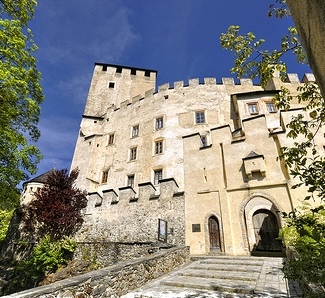

Location: Lienz, Tyrol Map
Constructed: 13th century
Burg Bruck, also known as Schloss Bruck, is a striking medieval castle perched on a hill overlooking the town of Lienz in East Tyrol, Austria. Situated at an elevation of 711 meters (2,333 feet) above sea level, the castle commands panoramic views of the Lienz basin and the lower Iseltal valley. Its name derives from the German word "Brücke," meaning bridge, referring to a bridge at the base of the castle hill. Built in the 13th century, it has served various roles over the centuries, from a noble residence to a military outpost, and now functions primarily as a museum and cultural venue.
The construction of Burg Bruck began around 1252 under the Counts of
Görz (also known as Gorizia), a powerful noble family in the region. It
was completed in 1278 as their primary residence, serving as a fortified
stronghold and administrative center in the Meinhardiner County of Görz.
In 1490, the castle's chapel was enhanced with intricate frescoes by the
renowned late Gothic artist Simon von Taisten, adding significant
artistic value.
By 1500, following the death of the last Count of
Gorizia, Leonhard, the castle was bequeathed to Holy Roman Emperor
Maximilian I of the House of Habsburg. It was subsequently integrated
into the Habsburg County of Tyrol, marking a shift in ownership and
purpose. During the French Revolutionary Wars in 1796, the castle was
briefly occupied by French troops under General Barthélemy Catherine
Joubert.
In later centuries, Burg Bruck adapted to changing needs: it
became an administrative seat for the Lords of Wolkenstein-Rodenegg, a
weapons stockpile, a military hospital during times of conflict, and
even a brewery. The city of Lienz acquired the castle in 1942, and since
1945, it has housed the Lienz Town Museum, transforming it into a
cultural hub.
Burg Bruck exemplifies medieval fortress architecture, designed for
both defense and representation. The complex features a prominent donjon
(keep), a tall tower that provided strategic oversight of the
surrounding valleys and served as a last line of defense. The castle
includes machicolations—overhanging projections with openings for
dropping projectiles on attackers—and a rounded patrol path for guards.
The structure is built from stone, with crenellated walls and multiple
levels of fortifications. The overall layout reflects a transition from
a purely defensive castle to a more residential palace, with elements
added over time to enhance comfort and aesthetics. One of the most
notable architectural highlights is the Chapel of the Most Holy Trinity,
a two-storey Romanesque building integrated into the castle. This chapel
boasts Gothic fresco cycles created by Simon von Taisten and Andrä
Peuerweg, depicting religious scenes with vivid detail and artistry. The
chapel's frescoes, dating back to 1490, make it a gem of late Gothic art
and a popular spot for civil ceremonies today.
Inside, Burg Bruck preserves a rich interior that blends historical
elements with modern museum displays. The museum, known as the Regional
Museum of Lienz or Lienz Town Museum, occupies much of the castle and
features an extensive collection of Gothic and Renaissance art,
including paintings, sculptures, and folk art from the region.
A
major draw is the gallery dedicated to Albin Egger-Lienz (1868–1926), an
East Tyrolean expressionist painter renowned for his depictions of rural
life, war, and mythological themes. The museum holds one of the largest
collections of his works, offering insights into his evolution as an
artist. The western wing of the castle is devoted to contemporary art
exhibitions, providing a contrast to the historical pieces.
The
castle's interiors also include period furnishings and artifacts that
reflect its noble past, with rooms that highlight the lifestyle of its
former inhabitants.
Today, Burg Bruck is owned by the city of Lienz and remains
well-preserved, open to the public as a museum and event space. It hosts
a variety of cultural events, such as theater performances, concerts,
literary readings, and soirées, making it a vibrant part of local life.
The surrounding castle park is noteworthy for its biodiversity, serving
as a habitat for about 15 species of bats. A themed trail with five
educational stations allows visitors to learn about these nocturnal
creatures. Access to the castle is via a short 5-minute walk from the
parking area at the foot of the hill, making it accessible for most
visitors. The site attracts those interested in history, art, and
architecture, offering guided tours that emphasize its chapel and museum
collections.